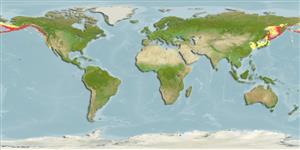>
Gadiformes (Cods) >
Gadidae (Cods and haddocks)
Etymology: Gadus: Latin, gadus = a fish, cod? (Ref. 45335); macrocephalus: macrocephalus meaning large head (Ref. 6885).
Environment: milieu / climate zone / depth range / distribution range
Sinh thái học
Biển; Thuộc về nước lợ gần đáy; Ở đại duơng, biển (Ref. 51243); Mức độ sâu 10 - 1280 m (Ref. 50550), usually 100 - 400 m (Ref. 54440). Boreal; 6°C - 9°C (Ref. 11800); 63°N - 31°N, 119°E - 119°W (Ref. 54440)
Arctic: Chukchi and Beaufort Seas eastward across Arctic Canada to western Greenland; south in the Atlantic Ocean to Gulf of St. Lawrence. Pacific Ocean: eastern Pacific to southern California at Santa Monica, and in the western Pacific to the Yellow Sea.
Length at first maturity / Bộ gần gũi / Khối lượng (Trọng lượng) / Age
Maturity: Lm 66.6, range 23 - 85 cm
Max length : 119 cm TL con đực/không giới tính; (Ref. 40637); Khối lượng cực đại được công bố: 22.7 kg (Ref. 27436); Tuổi cực đại được báo cáo: 25 các năm (Ref. 55701)
Các tia vây lưng cứng (tổng cộng): 0; Các vây lưng mềm (tổng cộng): 37-57; Tia cứng vây hậu môn 0; Tia mềm vây hậu môn: 31 - 42; Động vật có xương sống: 49 - 55. Distinguished by the presence of 3 dorsal and 2 anal fins, a long chin barbel (about 3/4 as long as the eye diameter in young, longer than eye diameter in adults), and a space between the second and third dorsal fins that is shorter than the eye diameter (Ref. 27547). Lateral line with a prominent arch under the 1st and 2nd dorsal fins, is straight toward the tail, ending under the 3rd dorsal (Ref. 27547). Brown or gray dorsally, becoming paler ventrally; dark spots or vermiculating patterns on the sides (Ref.1371). Yellow color phases are known (Ref. 27547). Fins dusky; dorsal, anal and caudal fins with white edges that are wider on anal and caudal than on dorsal (Ref. 27547).
Found mainly along the continental shelf and upper slopes (Ref. 1371). Form schools (Ref. 9988). They appear to be indiscriminate predators upon dominant food organisms present (Ref. 1371). Young probably feed on copepods and similar organisms (Ref. 27547). Adults feed on fishes, octopi, and large benthic and benthopelagic crustaceans (Ref. 1371); also worms. Parasites of the species include sealworm (Phocanema decipiens) in flesh, copepod (Lernaeocera branchialis) on gills and cestode (Pyramicocephalus phocarum) in the intestine (Ref. 5951). Marketed fresh and frozen for human consumption (Ref. 2850), and also dried or salted and smoked (Ref. 9988). Eaten steamed, fried, broiled, boiled, micro-waved and baked (Ref. 9988). Used in Chinese medicine (Ref. 12166). Minimum depth from Ref. 054440.
From late summer to mid-winter, fish move into the deeper water (100 to 250 m) of spawning areas; move inshore to depths of 30 to 60 m after spawning (Ref. 27547). Spawning occurs once a year (Ref. 120291).
Cohen, D.M., T. Inada, T. Iwamoto and N. Scialabba, 1990. FAO species catalogue. Vol. 10. Gadiform fishes of the world (Order Gadiformes). An annotated and illustrated catalogue of cods, hakes, grenadiers and other gadiform fishes known to date. FAO Fish. Synop. 125(10). Rome: FAO. 442 p. (Ref. 1371)
IUCN Red List Status (Ref. 130435)
Threat to humans
Harmless
Human uses
Các nghề cá: tính thương mại cao; cá để chơi: đúng
Các công cụ
Special reports
Download XML
Các nguồn internet
Estimates based on models
Preferred temperature (Ref.
123201): 0.5 - 6.4, mean 2.9 °C (based on 495 cells).
Phylogenetic diversity index (Ref.
82804): PD
50 = 0.6250 [Uniqueness, from 0.5 = low to 2.0 = high].
Bayesian length-weight: a=0.00724 (0.00627 - 0.00837), b=3.10 (3.06 - 3.14), in cm total length, based on LWR estimates for this species (Ref.
93245).
Mức dinh dưỡng (Ref.
69278): 4.2 ±0.1 se; based on diet studies.
Thích nghi nhanh (Ref.
120179): thấp, thời gian nhân đôi của chủng quần tối thiểu là 4.5 - 14 năm (Musick et al. 2000 (Ref.
36717); tmax=25; tm=3-8; K=0.11-0.27; Fec >1million).
Prior r = 0.34, 95% CL = 0.22 - 0.51, Based on 7 stock assessments.
Fishing Vulnerability (Ref.
59153): Moderate to high vulnerability (50 of 100).
Climate Vulnerability (Ref.
125649): Moderate to high vulnerability (45 of 100).
Nutrients (Ref.
124155): Calcium = 13.9 [9.0, 26.2] mg/100g; Iron = 0.194 [0.130, 0.305] mg/100g; Protein = 17.6 [16.1, 19.0] %; Omega3 = 0.377 [0.161, 0.932] g/100g; Selenium = 14.1 [4.9, 39.4] μg/100g; VitaminA = 4.51 [0.66, 26.54] μg/100g; Zinc = 0.353 [0.271, 0.433] mg/100g (wet weight); based on
nutrient studies.
